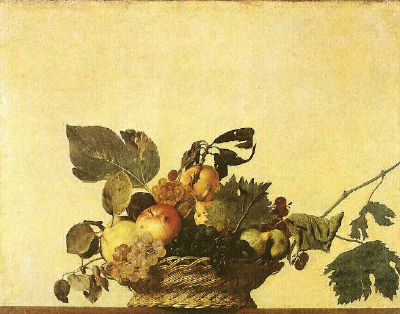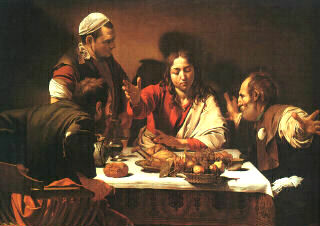Insights to Art
Caravaggio's Basket of Fruit

Caravaggio, Basket of Fruit - Ambrosiana Gallery, Milan

Caravaggio, Basket of Fruit (1597 or 1601; 31cm x 47cm)
A Mysterious Gift
Caravaggio's still-life painting of a Basket of Fruit (Canestro di frutta, or Cestino di frutta in Italian) was a gift from Cardinal Del Monte - the painter's first influential patron - to Federico Borromeo, the Archbishop of Milan, an avid collector of art who was ultimately responsible for the Ambrosiana Gallery (Pinacoteca Ambrosiana) in Milan where the painting is still housed. It is not known for certain when Caravaggio (real name Michelangelo Merisi [da Caravaggio]; b. 1573, d. 1610) painted the work, but it is generally dated 1597 or 1601. Still-life paintings were a complete novelty at that time, and for many years it was suggested that this small canvas was originally part of a larger painting that perhaps also contained religious figures. However, x-ray examinations have excluded such a possibility. Interestingly the x-rays also revealed that the canvas had already been used - beneath the basket of fruit there are signs of preparatory drawings for grotesque decorations, perhaps done by Caravaggio's artist friend Prospero Orsi, known as Prosperino delle Grottesche.
Caravaggio's Other Baskets of Fruit
The suggestion that this canvas was originally part of a larger painting stemmed from the fact that Caravaggio had included fruit in various other paintings of his, for example in his Young Bacchus, in his Young Man with a Fruit Basket, and even in sacred paintings such as his Supper at Emmaus (the version in the National Gallery, London, 1601). It is fascinating to see that the baskets of fruit in the still-life and in Supper at Emmaus are almost identical - the same kind of basket, the same collection of fruit and almost the same arrangement. Perhaps the still-life was a preparatory painting for the Supper at Emmaus, or perhaps vice-versa Caravaggio was so pleased with his still-life painting of the fruit basket that he decided to add the self-same basket to the Supper at Emmaus.

Caravaggio, Supper at Emmaus (1601)
Innovation
Before Caravaggio's Basket of Fruit, object paintings had been a great rarity, with just a handful of known works of this kind. Examples had been painted in Holland and Flanders, but it was Caravaggio who, thanks to this small canvas, made still-life one of the most popular of genres from the late Mannerist period on. Caravaggio may have been influenced by Dutch and Flemish painters; he may have wanted simply to fill a commission for a virtuoso piece. He may have seen some newly-discovered Roman frescos with similar subjects (the plain background is perhaps an indication of such a hypothesis); he may have been doing a preparatory work for his Supper at Emmaus. Whatever the reason why Caravaggio painted his still-life, it was a revolutionary step in Italian art. For the first time a simple basket of fruit became the centre of attention in an Italian painting, not simply a decorative addition. And Caravaggio chose as his subject an everyday wicker basket with some not-very-fresh fruit, the kind of fruit basket that might be found on the table of a humble family. Such a subject puts the very values of painting into the foreground. It is almost a declaration of war on official painting, a declaration of war on the pomp and finery of the main patron of art of the time - the Catholic Church. Many art historians of the past felt that it was impossible that Caravaggio only painted one still-life, and many other works have at times been attributed to him, some by unknown followers. Indeed Caravaggio had a great following in Rome as well as in Spain, France and the Low Countries, and still-lifes abound among the works of the Caravaggesque painters.
A Quest for Realistic Detail
As in the Supper at Emmaus, the basket of fruit in the still-life juts out over the edge of the surface it is standing on, making it emerge from the flat plane of the canvas. Seen at eye level, the basket is full of all the realism the painter could manage to put into his subject. Caravaggio supposedly asserted that he put as much time and effort into painting a vase of flowers as a human figure, and this painting would seem to confirm such an approach - a true break with the ideas of painting up until then. He has painstakingly reproduced the woven wickerwork of the basket, using light and shade to the utmost. Likewise every grape has been carefully painted to highlight its roundness. His quest for realism also extends to the other fruit, especially the maggot-eaten apple, and the withering leaves.
Contents of the Basket
The basket of fruit contains a collection of fruit which has attracted the interest of historical horticulturists and art historians alike. The six fruits shown are: a peach, an apple, a pear, four figs, a quince and four clusters of grapes. In addition there are some twigs and leaves from some of the fruit. Anything more than a cursory glance at the basket of fruit reveals that the fruit and the greenery is not all perfect. The top fruit, the peach, is still attached to a stem with a grub-eaten leaf. A little beneath the peach is an apple with very visible signs of holes where maggots have eaten into the fruit. The pear to the right of the apple is also damaged by insects. The two white and two purple figs - the purple ones are over-ripe and splitting - are accompanied by a large fig leaf with evident signs of fungal infection. The leaf of the unblemished quince on the left likewise has signs of leaf rot. The four different kinds of grape also display various imperfections, one or two grapes are shrivelled, others are over-ripe. One of the vine leaves is withering, while another has spotted leaf-blight. The vine twig jutting out to the right has some eaten leaves; the pear or quince twig to the left has rather drooping leaves.
Meanings
Caravaggio has intentionally chosen to paint a collection of very imperfect fruit and leaves. Clearly, four-hundred years ago fruit would not all be as supermarket-perfect as it is today, but the many signs of decomposition are obviously there for a purpose. The contents of the basket show the natural process of decay that is part of all living things. Caravaggio wants to remind us that everything in life is transitory - an apparently delicious collection of fruit is not destined to survive for long. At the same time, the apple at the heart of the picture still has an unwrinkled skin, despite its maggot holes … though we realise that much of the apple will be bad inside. An almost perfect exterior can therefore hide a rotten interior. And this is generally considered the moral of the painting: it is often a badness inside that ruins an outer God-given perfection. Caravaggio was not new to such pessimistic interpretations of life, and this kind of work is known as a Vanitas still-life, recalling the Latin adage "Vanitas vanitatum". As Anne Brontë wrote in her poem Vanitas Vanitatum Omina Vanitas "Thankful for all that God has given, … Knowing that earthly joys decay".
Symbolic Interpretations
Various other meanings have also been suggested for the painting, not least because fruits are often given associations and symbolic interpretations in art. Peaches generally represent immortality and salvation, while apples symbolise love and fertility. But apples also have biblical associations relating to temptation and evil. Figs represent femininity, fertility and riches, often with erotic overtones. Adam and Eve wore fig leaves to hide their nakedness, hence fig leaves also represent a loss of innocence. In Christian terms, pears stand for Christ's love for mankind. Grapes, through wine, are symbols of happiness and immortality, but in the Christian tradition they are also associated with blood and sacrifice. Commentators have come up with various interpretations of the collection of fruit shown in the still-life, interpretations which range from insights into Caravaggio's inner personal torments, through explanations of a religious nature, to even highly erotic connotations. A basket of fruit can be a symbol of nourishment, fulfilment, spiritual as well as physical satisfaction: "the fruits of one's exertions". Religious interpretations usually centre around original sin, as represented by the apple, figs and fig leaves, being redeemed by Christ's sacrifice, as symbolised by the grapes and vine leaves. In such an interpretation, the peach at the top of the composition may represent resurrection and salvation. The transience of life as suggested by the decaying fruit can also be linked to this idea: salvation only comes through death and pain.
© Nigel J. Ross, 2003
Home |
Publications |
Dictionaries |
English Lang. |
Art Insights |
Travel |
Links | ||||||